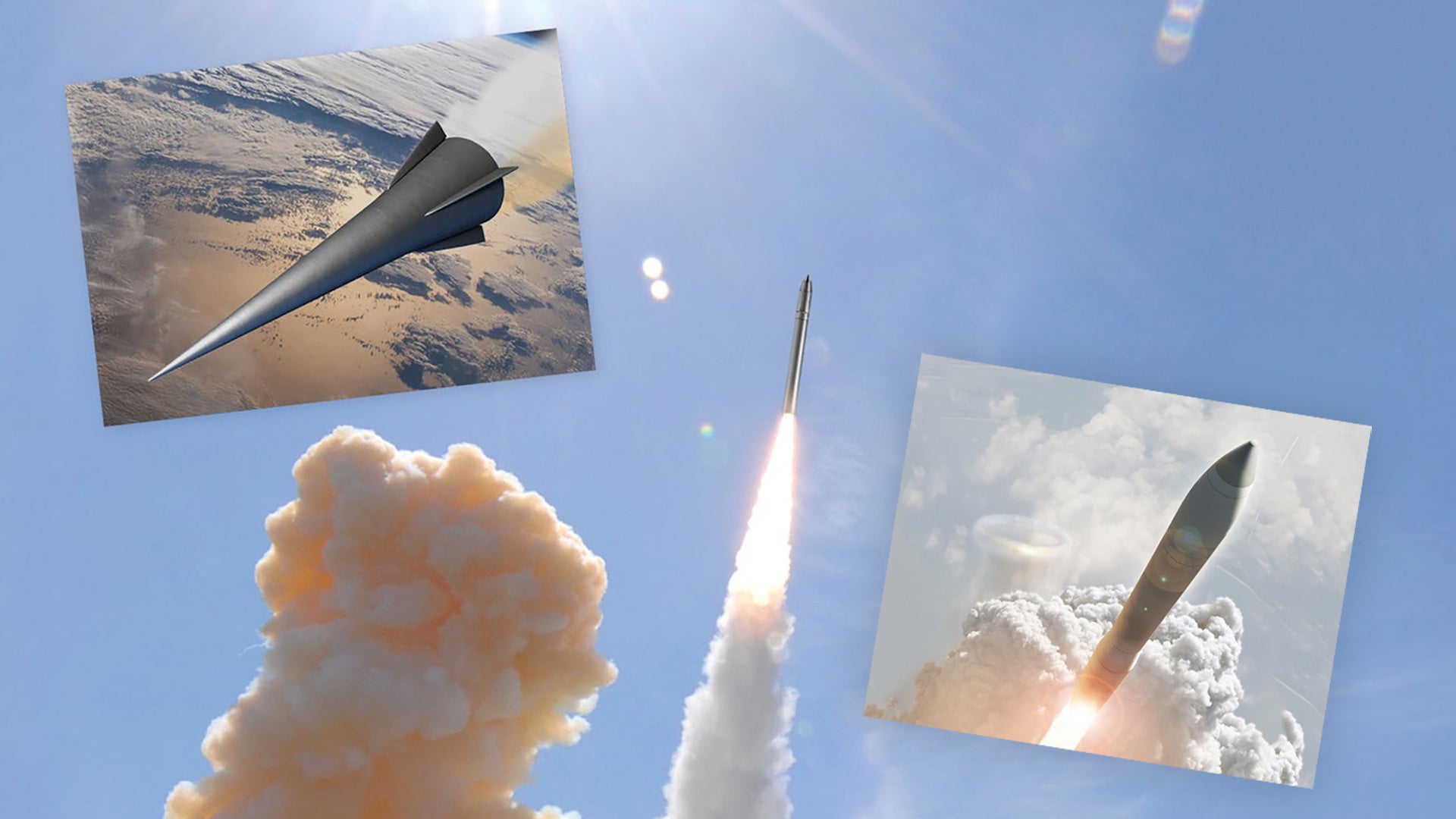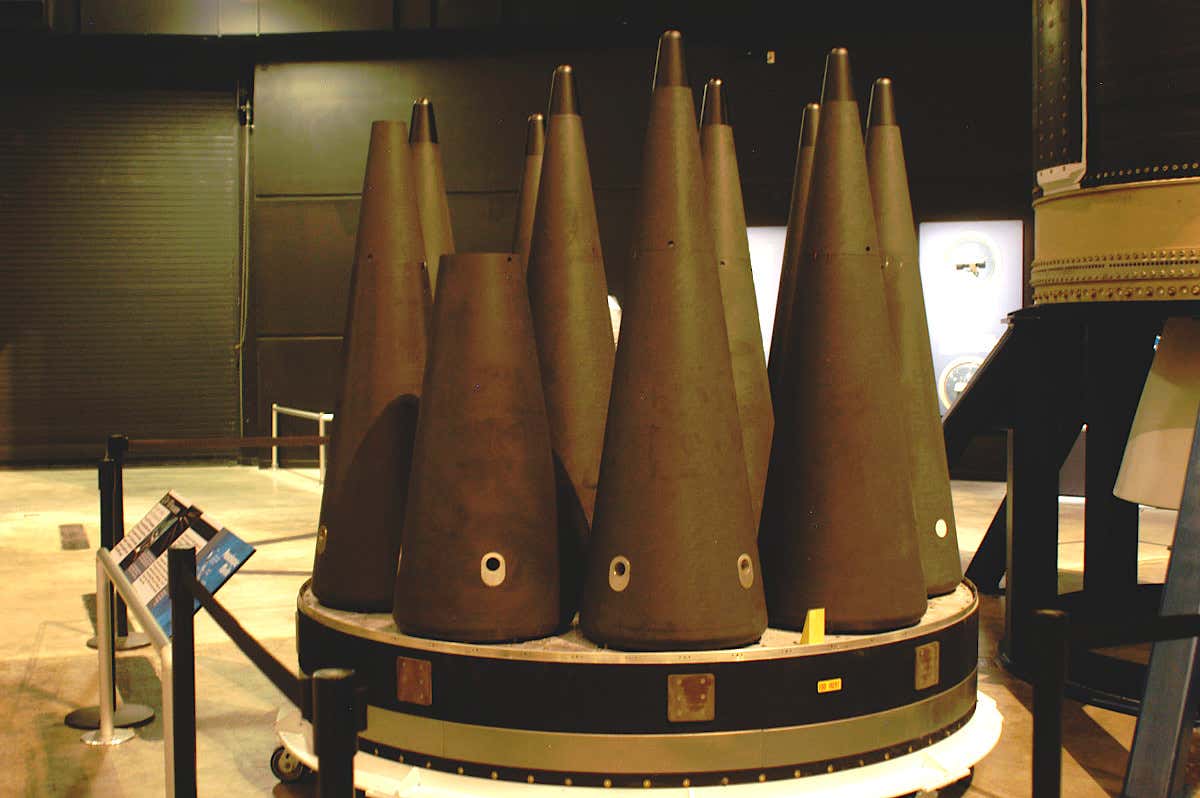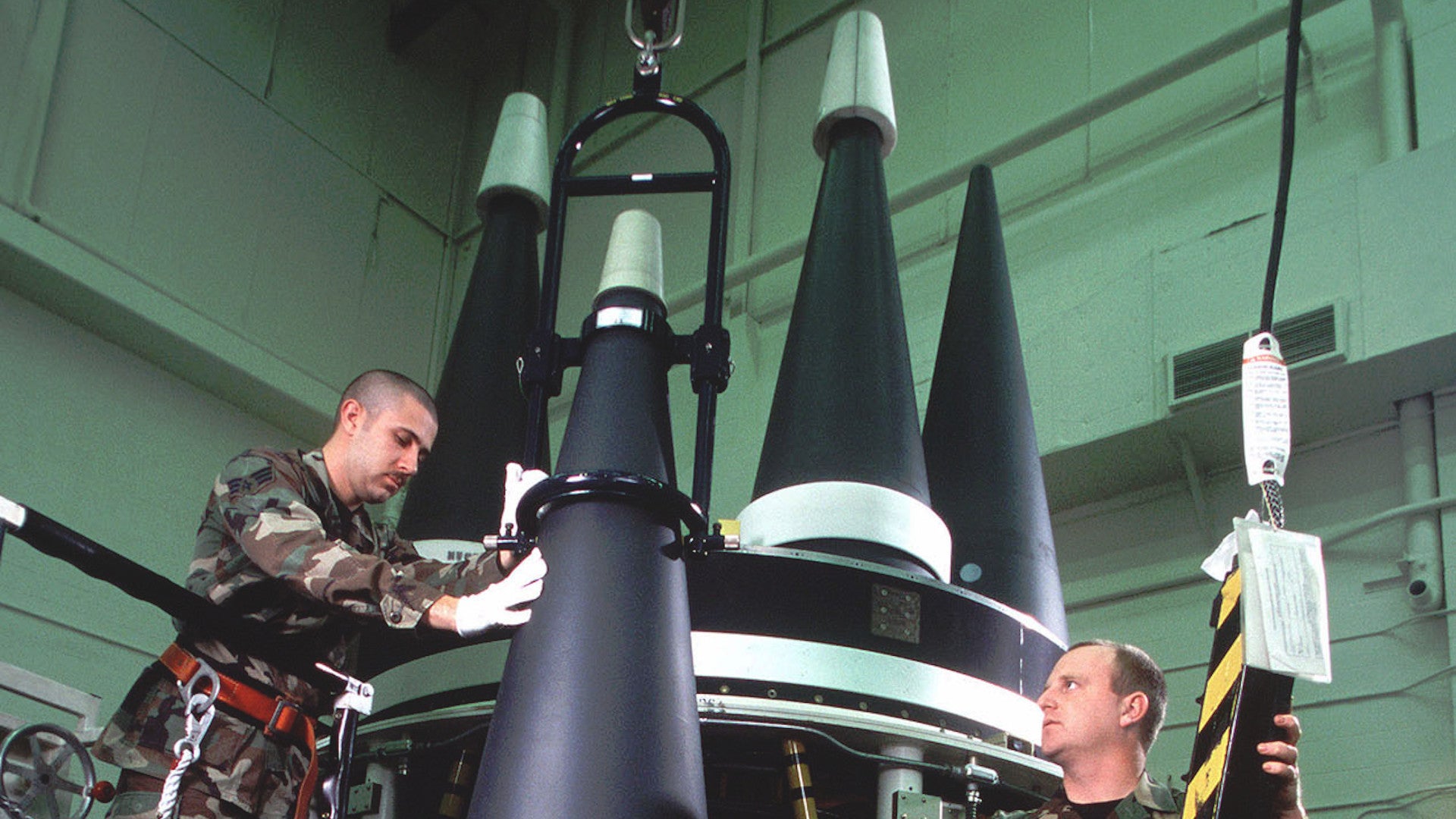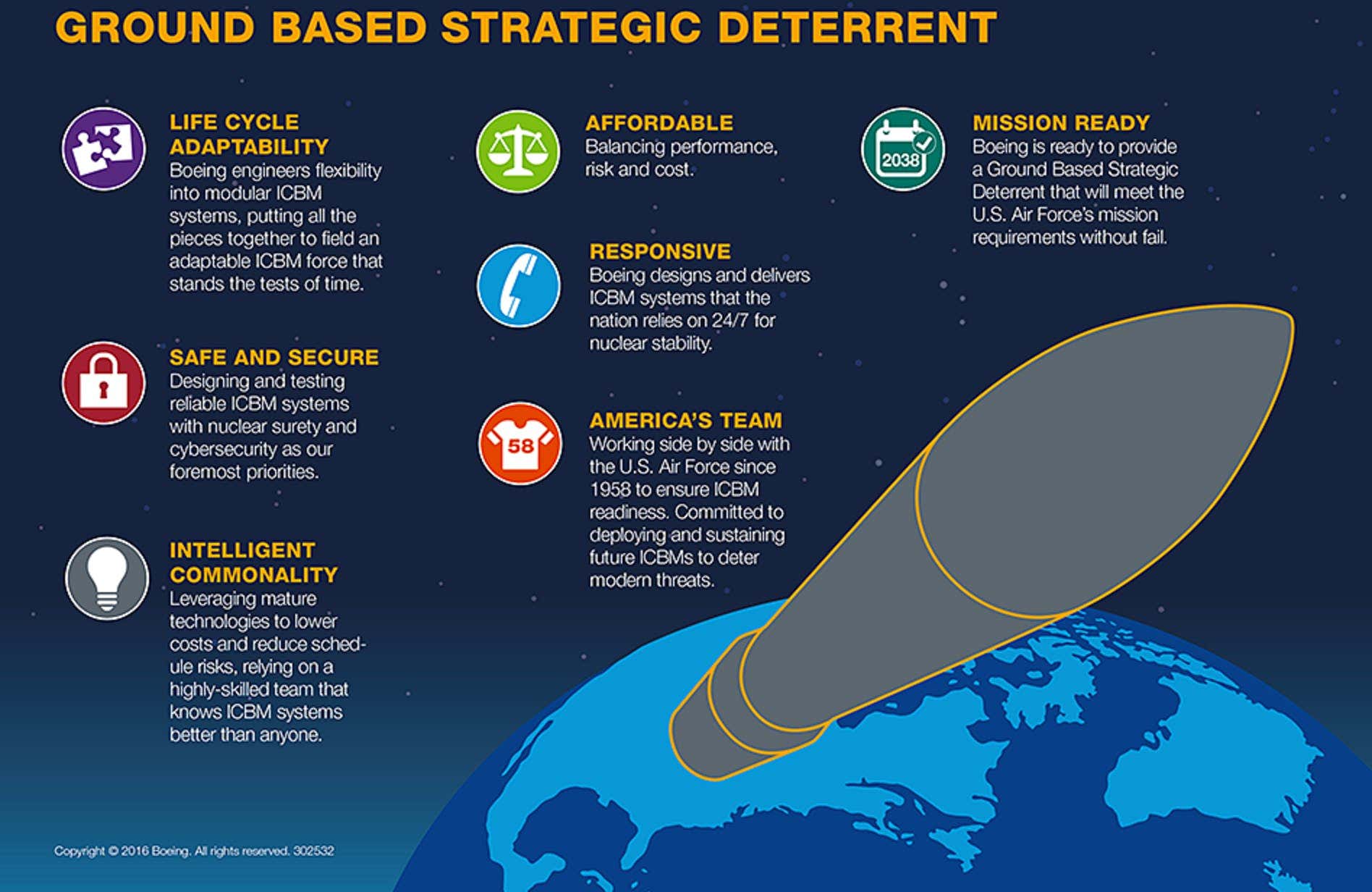Winston
Lorenzo von Matterhorn
- Joined
- Jan 31, 2009
- Messages
- 9,560
- Reaction score
- 1,748
Ground Based Strategic Deterrent
https://en.wikipedia.org/wiki/Ground_Based_Strategic_Deterrent
The Ground Based Strategic Deterrent (GBSD) is a US land-based intercontinental ballistic missile system in the early stages of development, slated to replace all 450 Minuteman III missiles in service with the United States Air Force from 2027 onward.
History
A request for proposal for development and maintenance of a next-generation nuclear ICBM was made by the US Air Force Nuclear Weapons Center, ICBM Systems Directorate, GBSD Division in July 2016. The GBSD would replace the Minuteman III in the land based portion of the US nuclear triad. The new missiles, to be phased in over a decade from the late 2020s, are estimated over a fifty-year life cycle to cost around $86 billion. Boeing and Northrop Grumman competed for the contract. In August 2017, the Air Force awarded 3-year development contracts to Boeing and Northrop Grumman for $349 million and $329 million, respectively. One of these companies was to be selected to produce a ground-based nuclear ICBM in 2020. In 2027, the GBSD program is expected to enter service and remain active until 2075.
On 25 July 2019, Boeing announced it would not place a bid for the program, citing Northrop's recent acquisition of Orbital ATK (now Northrop Grumman Innovation Systems), Boeing's supplier of solid rocket motors. Northrop signed an agreement to firewall Boeing's proprietary data after acquiring Orbital ATK. The Air Force has since halted funding for the Boeing project, leaving only Northrop Grumman as a bidder.
In December 2019, it was announced that Northrop Grumman won the competition to build the future ICBM. Northrop won by default, as their bid was the only bid left to be considered for the GBSD program. The Air Force said that they will "proceed with an aggressive and effective sole-source negotiation" in reference to Northrop's bid.
Warhead
In March 2019 the W87 mod 1 thermonuclear warhead was selected for GBSD, replacing the W78 warhead currently used in Minuteman III. It is unclear if the W78 will be fitted to GBSD or if some other arrangement such as moving W87-0s to GBSD first will be made, but the estimated first production unit date was moved to 2030, a delay from the initial estimated entry into service date of 2027.
W78
https://en.wikipedia.org/wiki/W78
The W78 thermonuclear warhead is the warhead used on most of the United States LGM-30G Minuteman III intercontinental ballistic missiles (ICBMs), along with the MK-12A reentry vehicle which carried the warhead. Minuteman IIIs initially deployed with the older W62 warhead; the W78 was deployed starting in December 1979 onto 300 missiles, three warheads per missile. Declassified records indicate a total of 1,083 W78s were produced.
The W78 was designed at Los Alamos National Laboratory starting in 1974. The design is thought to combine the secondary (fusion) stage design of older ICBM warheads such as the W50 with a more modern primary stage (see Teller-Ulam design for more details).
The W78 has a publicly announced yield of 335–350 kilotons of TNT (1.40–1.46 PJ).
Dimensions of the W78 are unknown, but it fits within the MK-12A reentry vehicle, which is conically shaped, 21.3 inches in diameter at its base and 71.3 inches long. The W78 is estimated to weigh 700–800 pounds (317–363 kg).
The W78 Lives On
https://www.lanl.gov/discover/publi...ber/_assets/docs/NSS-dec2016_w78-lives-on.pdf
Joint Test Assembly flight tests evaluate the Minuteman III’s aging warhead. The W78 warhead, which was designed by Los Alamos and is one of the two types used to arm Minuteman III ICBMs, will turn 40 in 2019. One way to evaluate the health of the aging W78 is by Joint Test Assembly (JTA) flight tests. These joint Department of Energy-Department of Defense tests gather key data from the sophisticated sensors inside the missile, the reentry vehicle (RV), and the W78 warhead tucked inside the RV. These data provide weapons scientists and engineers a way to assess the warhead’s ability to survive and function while traveling through multiple severe environments: the extreme violence of launching; accelerating within seconds to Mach 23 (about 18,000 miles per hour); entering the frigid vacuum of space; then reentering the atmosphere at speeds that threaten to break up or burn up the reentry vehicle and its warhead.
The key to a JTA, however, is that it uses a mock nuclear warhead: surrogate materials have replaced all of the nuclear materials inside. For example, the W78’s plutonium pit is replaced with a pit of non-nuclear material, making this mock-warhead incapable of generating any nuclear yield. The mock warhead is otherwise all but identical to a real warhead. All types of nuclear warheads are flight-tested using JTAs. Because Los Alamos designed the W78 (and the W88, W76, and B61 warheads), it provides the mock warheads for those JTA flight-tests. Although the mock warhead is technically a “dud,” JTAs are still one of the best ways to provide confidence that the W78 remains safe, secure, and reliable.
W87-1 Modification Program
https://www.energy.gov/sites/prod/files/2019/03/f60/2019-03-08-FACTSHEET-W87-1.pdf
NNSA resumed work on a W78 warhead replacement, designated as the W87-1, in fiscal year (FY) 2019 following the 2018 Nuclear Posture Review. By replacing the legacy W78, the W87-1 will maintain continuity for the ground-based leg of the U.S. nuclear deterrent. The warhead is named the W87-1 to reflect that it has a similar primary design to the W87-0 and will fly in a similar reentry vehicle. The W87-1 is based on a previously-tested nuclear component and will include an insensitive high explosive primary that had been designed and tested with advanced safety features. The warhead will be fielded by FY 2030 on the U.S. Air Force (USAF)’s Ground Based Strategic Deterrent. The W87-1 will not provide new military capabilities, yet it will provide enhanced safety and security compared to the legacy W78. The W87-1 will be certified without the need for additional underground nuclear explosive testing.
Air Force Eyes Adding Nuclear-Armed Hypersonic Boost-Glide Vehicles To Its Future ICBMs
At present, all other hypersonic weapons of this type that the US military is developing are conventionally armed.
AUGUST 19, 2020
https://www.thedrive.com/the-war-zo...onic-boost-glide-vehicles-to-its-future-icbms
The U.S. Air Force is at least researching what it might take to develop a nuclear-armed hypersonic boost-glide vehicle with a range equivalent to a traditional intercontinental ballistic missile, or ICBM. This vehicle could potentially go on top of the service's future Ground-Based Strategic Deterrent ICBMs, which are now in development. Publicly, the hypersonic weapons programs now in progress across the U.S. military are all conventionally-armed.
Aviation Week was first to report on this potential nuclear hypersonic weapon effort on Aug. 18, 2020, based on information the Air Force Nuclear Weapons Center had included in a request for information posted online six days earlier. That document, which was marked "For Official Use Only" and has since been taken offline, outlined seven potential upgrade tracks for an ICBM with a “modular open architecture."
This is understood to refer to the forthcoming Ground-Based Strategic Deterrent (GBSD), because the existing Minuteman III IBCM was not designed with these features in mind. One of those areas of interest is “thermal protection system that can support [a] hypersonic glide to ICBM ranges."
"GBSD does have an open architecture. It gives us an ability to incorporate emerging technologies we need to counter whatever threats we face in the future," Air Force Lieutenant General Richard Clark, the Deputy Chief of Staff for Strategic Deterrence and Nuclear Integration, said in response to a specific question about a potential nuclear-armed hypersonic payload during a virtual event hosted by the Air Force Association's Mitchell Institute on Aug. 19, 2020. "So as we bring the system [GBSD] online, we will ensure that we have the ability to roll different technologies in and incorporate that into GBSD."
In response to a follow-up question from Steve Trimble, Aviation Week's Defense Editor and good friend of The War Zone, Clark explicitly said that a nuclear-armed hypersonic boost-glide vehicle was not in the minimum "threshold" requirements for the GBSD program. However, as Trimble astutely pointed out, this only raises questions about what the program's more ambitious "objective" requirements might include.

https://en.wikipedia.org/wiki/Ground_Based_Strategic_Deterrent
The Ground Based Strategic Deterrent (GBSD) is a US land-based intercontinental ballistic missile system in the early stages of development, slated to replace all 450 Minuteman III missiles in service with the United States Air Force from 2027 onward.
History
A request for proposal for development and maintenance of a next-generation nuclear ICBM was made by the US Air Force Nuclear Weapons Center, ICBM Systems Directorate, GBSD Division in July 2016. The GBSD would replace the Minuteman III in the land based portion of the US nuclear triad. The new missiles, to be phased in over a decade from the late 2020s, are estimated over a fifty-year life cycle to cost around $86 billion. Boeing and Northrop Grumman competed for the contract. In August 2017, the Air Force awarded 3-year development contracts to Boeing and Northrop Grumman for $349 million and $329 million, respectively. One of these companies was to be selected to produce a ground-based nuclear ICBM in 2020. In 2027, the GBSD program is expected to enter service and remain active until 2075.
On 25 July 2019, Boeing announced it would not place a bid for the program, citing Northrop's recent acquisition of Orbital ATK (now Northrop Grumman Innovation Systems), Boeing's supplier of solid rocket motors. Northrop signed an agreement to firewall Boeing's proprietary data after acquiring Orbital ATK. The Air Force has since halted funding for the Boeing project, leaving only Northrop Grumman as a bidder.
In December 2019, it was announced that Northrop Grumman won the competition to build the future ICBM. Northrop won by default, as their bid was the only bid left to be considered for the GBSD program. The Air Force said that they will "proceed with an aggressive and effective sole-source negotiation" in reference to Northrop's bid.
Warhead
In March 2019 the W87 mod 1 thermonuclear warhead was selected for GBSD, replacing the W78 warhead currently used in Minuteman III. It is unclear if the W78 will be fitted to GBSD or if some other arrangement such as moving W87-0s to GBSD first will be made, but the estimated first production unit date was moved to 2030, a delay from the initial estimated entry into service date of 2027.
W78
https://en.wikipedia.org/wiki/W78
The W78 thermonuclear warhead is the warhead used on most of the United States LGM-30G Minuteman III intercontinental ballistic missiles (ICBMs), along with the MK-12A reentry vehicle which carried the warhead. Minuteman IIIs initially deployed with the older W62 warhead; the W78 was deployed starting in December 1979 onto 300 missiles, three warheads per missile. Declassified records indicate a total of 1,083 W78s were produced.
The W78 was designed at Los Alamos National Laboratory starting in 1974. The design is thought to combine the secondary (fusion) stage design of older ICBM warheads such as the W50 with a more modern primary stage (see Teller-Ulam design for more details).
The W78 has a publicly announced yield of 335–350 kilotons of TNT (1.40–1.46 PJ).
Dimensions of the W78 are unknown, but it fits within the MK-12A reentry vehicle, which is conically shaped, 21.3 inches in diameter at its base and 71.3 inches long. The W78 is estimated to weigh 700–800 pounds (317–363 kg).
The W78 Lives On
https://www.lanl.gov/discover/publi...ber/_assets/docs/NSS-dec2016_w78-lives-on.pdf
Joint Test Assembly flight tests evaluate the Minuteman III’s aging warhead. The W78 warhead, which was designed by Los Alamos and is one of the two types used to arm Minuteman III ICBMs, will turn 40 in 2019. One way to evaluate the health of the aging W78 is by Joint Test Assembly (JTA) flight tests. These joint Department of Energy-Department of Defense tests gather key data from the sophisticated sensors inside the missile, the reentry vehicle (RV), and the W78 warhead tucked inside the RV. These data provide weapons scientists and engineers a way to assess the warhead’s ability to survive and function while traveling through multiple severe environments: the extreme violence of launching; accelerating within seconds to Mach 23 (about 18,000 miles per hour); entering the frigid vacuum of space; then reentering the atmosphere at speeds that threaten to break up or burn up the reentry vehicle and its warhead.
The key to a JTA, however, is that it uses a mock nuclear warhead: surrogate materials have replaced all of the nuclear materials inside. For example, the W78’s plutonium pit is replaced with a pit of non-nuclear material, making this mock-warhead incapable of generating any nuclear yield. The mock warhead is otherwise all but identical to a real warhead. All types of nuclear warheads are flight-tested using JTAs. Because Los Alamos designed the W78 (and the W88, W76, and B61 warheads), it provides the mock warheads for those JTA flight-tests. Although the mock warhead is technically a “dud,” JTAs are still one of the best ways to provide confidence that the W78 remains safe, secure, and reliable.
W87-1 Modification Program
https://www.energy.gov/sites/prod/files/2019/03/f60/2019-03-08-FACTSHEET-W87-1.pdf
NNSA resumed work on a W78 warhead replacement, designated as the W87-1, in fiscal year (FY) 2019 following the 2018 Nuclear Posture Review. By replacing the legacy W78, the W87-1 will maintain continuity for the ground-based leg of the U.S. nuclear deterrent. The warhead is named the W87-1 to reflect that it has a similar primary design to the W87-0 and will fly in a similar reentry vehicle. The W87-1 is based on a previously-tested nuclear component and will include an insensitive high explosive primary that had been designed and tested with advanced safety features. The warhead will be fielded by FY 2030 on the U.S. Air Force (USAF)’s Ground Based Strategic Deterrent. The W87-1 will not provide new military capabilities, yet it will provide enhanced safety and security compared to the legacy W78. The W87-1 will be certified without the need for additional underground nuclear explosive testing.
Air Force Eyes Adding Nuclear-Armed Hypersonic Boost-Glide Vehicles To Its Future ICBMs
At present, all other hypersonic weapons of this type that the US military is developing are conventionally armed.
AUGUST 19, 2020
https://www.thedrive.com/the-war-zo...onic-boost-glide-vehicles-to-its-future-icbms
The U.S. Air Force is at least researching what it might take to develop a nuclear-armed hypersonic boost-glide vehicle with a range equivalent to a traditional intercontinental ballistic missile, or ICBM. This vehicle could potentially go on top of the service's future Ground-Based Strategic Deterrent ICBMs, which are now in development. Publicly, the hypersonic weapons programs now in progress across the U.S. military are all conventionally-armed.
Aviation Week was first to report on this potential nuclear hypersonic weapon effort on Aug. 18, 2020, based on information the Air Force Nuclear Weapons Center had included in a request for information posted online six days earlier. That document, which was marked "For Official Use Only" and has since been taken offline, outlined seven potential upgrade tracks for an ICBM with a “modular open architecture."
This is understood to refer to the forthcoming Ground-Based Strategic Deterrent (GBSD), because the existing Minuteman III IBCM was not designed with these features in mind. One of those areas of interest is “thermal protection system that can support [a] hypersonic glide to ICBM ranges."
"GBSD does have an open architecture. It gives us an ability to incorporate emerging technologies we need to counter whatever threats we face in the future," Air Force Lieutenant General Richard Clark, the Deputy Chief of Staff for Strategic Deterrence and Nuclear Integration, said in response to a specific question about a potential nuclear-armed hypersonic payload during a virtual event hosted by the Air Force Association's Mitchell Institute on Aug. 19, 2020. "So as we bring the system [GBSD] online, we will ensure that we have the ability to roll different technologies in and incorporate that into GBSD."
In response to a follow-up question from Steve Trimble, Aviation Week's Defense Editor and good friend of The War Zone, Clark explicitly said that a nuclear-armed hypersonic boost-glide vehicle was not in the minimum "threshold" requirements for the GBSD program. However, as Trimble astutely pointed out, this only raises questions about what the program's more ambitious "objective" requirements might include.







